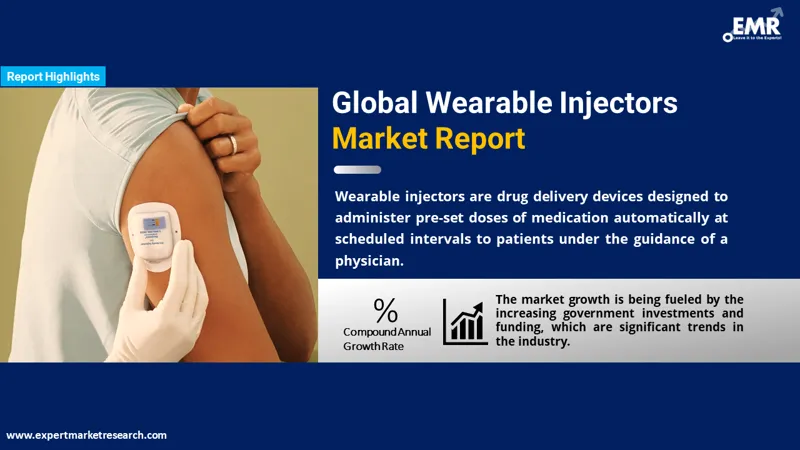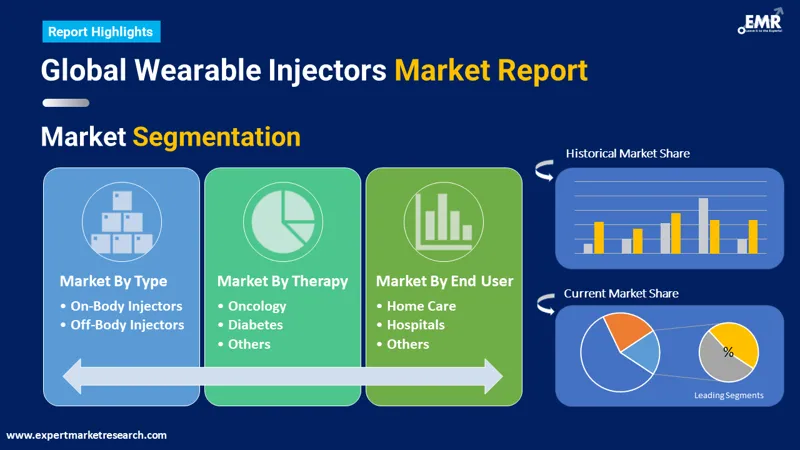
Consumer Insights
Uncover trends and behaviors shaping consumer choices today
Procurement Insights
Optimize your sourcing strategy with key market data
Industry Stats
Stay ahead with the latest trends and market analysis.
The global wearable injectors market size reached a value of around USD 8.88 Billion in 2025, driven by the rising prevalence of chronic disorders. The market is further expected to grow at a CAGR of 11.90% during the forecast period of 2026-2035, likely to attain a value of around USD 27.33 Billion by 2035.
Base Year
Historical Period
Forecast Period
Compound Annual Growth Rate
11.9%
Value in USD Billion
2026-2035
*this image is indicative*
Wearable injectors refer to drug delivery devices that are used to deliver drug doses to the body. These drugs are delivered automatically on pre-set doses to the patient on set intervals, which is administered by the physician.

Read more about this report - REQUEST FREE SAMPLE COPY IN PDF
The growth of the market is significantly being driven by the rising prevalence of chronic diseases like diabetes and cancer, among others. The growth of the market is also being driven by the rapid technological advancements in the healthcare sectors, along with the growing emphasis of the governments on improved healthcare infrastructure and facilities. Higher investment and funding by the governments and healthcare organisations are also providing a significant impetus to the growth of the market.
Wearable Injectors Market Report and Forecast 2026-2035 offers a detailed analysis of the market based on the following segments:
Market Breakup by Type
Market Breakup by Therapy
Market Breakup by End User
Market Breakup by Region

Read more about this report - REQUEST FREE SAMPLE COPY IN PDF
The market for wearable injectors has been witnessing robust growth and is anticipated to continue witnessing demand in the coming years with the rapidly developing healthcare sector. Among the regional markets, North America is anticipated to lead the global market as the region has the highest presence of the key players.
Apart from North America, Asia Pacific is also anticipated to register significant growth in the coming years owing to the rising prevalence of chronic conditions in the region, especially amongst the geriatric population. The favourable policies by the government for the use of these devices is likely to bolster the growth of the market.
The comprehensive EMR report provides an in-depth assessment of the market based on Porter's five forces model, along with giving a SWOT analysis. The report gives a detailed analysis of the following key players in the global wearable injectors market, covering their competitive landscape and the latest developments like mergers, acquisitions, investments, and expansion plans.
The key features of the market report include patent analysis, grants analysis, clinical trials analysis, funding and investment analysis, partnerships, and collaborations analysis by the leading key players.




*While we strive to always give you current and accurate information, the numbers depicted on the website are indicative and may differ from the actual numbers in the main report. At Expert Market Research, we aim to bring you the latest insights and trends in the market. Using our analyses and forecasts, stakeholders can understand the market dynamics, navigate challenges, and capitalize on opportunities to make data-driven strategic decisions.*
Get in touch with us for a customized solution tailored to your unique requirements and save upto 35%!
The market attained a value of USD 8.88 Billion in 2025.
The market is anticipated to grow at a CAGR of 11.90% during the forecast period of 2026-2035 to attain a value of around USD 27.33 Billion by 2035.
The growth of the market is driven by factors like rising prevalence of chronic disorders and the rapid technological advancements.
The key trends which are bolstering the market growth include the rising investment and funding by the government.
The major regional markets include North America, Europe, Asia Pacific, Latin America, Middle East and Africa.
The types can be categorized into on-body injectors and off-body injectors.
The therapies in the market include oncology, autoimmune disease, diabetes, and cardiovascular disease, among others.
The end-users in the market include hospitals, diagnostic centres, and home care, among others.
The key players in the market can be categorised into Amgen, Becton, Dickinson and Company, Dexcom, Inc., Enable Injections, Insulet Corporation, Sensile Medical, Tandem Diabetes Care, Ypsomed, Johnson & Johnson Services, F. Hoffmann-La Roche Ltd, Unilife Corporation, SteadyMed Therapeutics, Insulet Corporation, and CeQur SA.
Explore our key highlights of the report and gain a concise overview of key findings, trends, and actionable insights that will empower your strategic decisions.
| REPORT FEATURES | DETAILS |
| Base Year | 2025 |
| Historical Period | 2019-2025 |
| Forecast Period | 2026-2035 |
| Scope of the Report |
Historical and Forecast Trends, Industry Drivers and Constraints, Historical and Forecast Market Analysis by Segment:
|
| Breakup by Type |
|
| Breakup by Therapy |
|
| Breakup by End User |
|
| Breakup by Region |
|
| Market Dynamics |
|
| Supplier Landscape |
|
| Companies Covered |
|
Datasheet
One User
USD 3,299
USD 2,969
tax inclusive*
Single User License
One User
USD 5,499
USD 4,949
tax inclusive*
Five User License
Five User
USD 6,999
USD 5,949
tax inclusive*
Corporate License
Unlimited Users
USD 8,199
USD 6,969
tax inclusive*
*Please note that the prices mentioned below are starting prices for each bundle type. Kindly contact our team for further details.*
Flash Bundle
Small Business Bundle
Growth Bundle
Enterprise Bundle
*Please note that the prices mentioned below are starting prices for each bundle type. Kindly contact our team for further details.*
Flash Bundle
Number of Reports: 3
20%
tax inclusive*
Small Business Bundle
Number of Reports: 5
25%
tax inclusive*
Growth Bundle
Number of Reports: 8
30%
tax inclusive*
Enterprise Bundle
Number of Reports: 10
35%
tax inclusive*
How To Order

Select License Type
Choose the right license for your needs and access rights.

Click on ‘Buy Now’
Add the report to your cart with one click and proceed to register.

Select Mode of Payment
Choose a payment option for a secure checkout. You will be redirected accordingly.
Gain insights to stay ahead and seize opportunities.

Get insights & trends for a competitive edge.

Track prices with detailed trend reports.

Analyse trade data for supply chain insights.

Leverage cost reports for smart savings

Enhance supply chain with partnerships.

Connect For More Information
Our expert team of analysts will offer full support and resolve any queries regarding the report, before and after the purchase.
Our expert team of analysts will offer full support and resolve any queries regarding the report, before and after the purchase.
We employ meticulous research methods, blending advanced analytics and expert insights to deliver accurate, actionable industry intelligence, staying ahead of competitors.
Our skilled analysts offer unparalleled competitive advantage with detailed insights on current and emerging markets, ensuring your strategic edge.
We offer an in-depth yet simplified presentation of industry insights and analysis to meet your specific requirements effectively.
Share